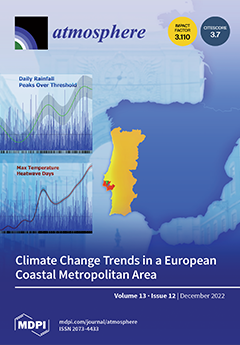A sensitive, compact detector for the simultaneous measurement of O
3 and NO
2 is presented in this work. There are two channels in the detector, namely the O
x channel and the NO
2 channel. In the presence of excess NO, ambient
[...] Read more.
A sensitive, compact detector for the simultaneous measurement of O
3 and NO
2 is presented in this work. There are two channels in the detector, namely the O
x channel and the NO
2 channel. In the presence of excess NO, ambient O
3 is converted to NO
2 in the O
x measurement channel. In both channels, NO
2 is directly detected via cavity ring-down spectroscopy (CRDS) at 409 nm. At a 10 s integration time, the O
x and NO
2 channels have a 1σ precision of 14.5 and 13.5 pptv, respectively. The Allan deviation plot shows that the optimal sensitivity of O
3 and NO
2 occurs at an integration time of ~60 s, with values of 10.2 and 8.5 pptv, respectively. The accuracy is 6% for the O
3 channel and 5% for the NO
2 channel, and the largest uncertainty comes from the effective NO
2 absorption cross-section. Intercomparison of the NO
2 detection between the NO
2 and O
x channels shows good agreement within their uncertainties, with an absolute shift of 0.31 ppbv, a correlation coefficient of R
2 = 0.99 and a slope of 0.98. Further intercomparison for ambient O
3 measurement between the O
3/NO
2-CRDS developed in this work and a commercial UV O
3 monitor also shows excellent agreement, with linear regression slopes close to unity and an R
2 value of 0.99 for 1 min averaged data. The system was deployed to measure O
3 and NO
2 concentrations in Hefei, China, and the observation results show obvious diurnal variation characteristics. The successful deployment of the system has demonstrated that the instrument can provide a new method for retrieving fast variations in ambient O
3 and NO
2.
Full article





